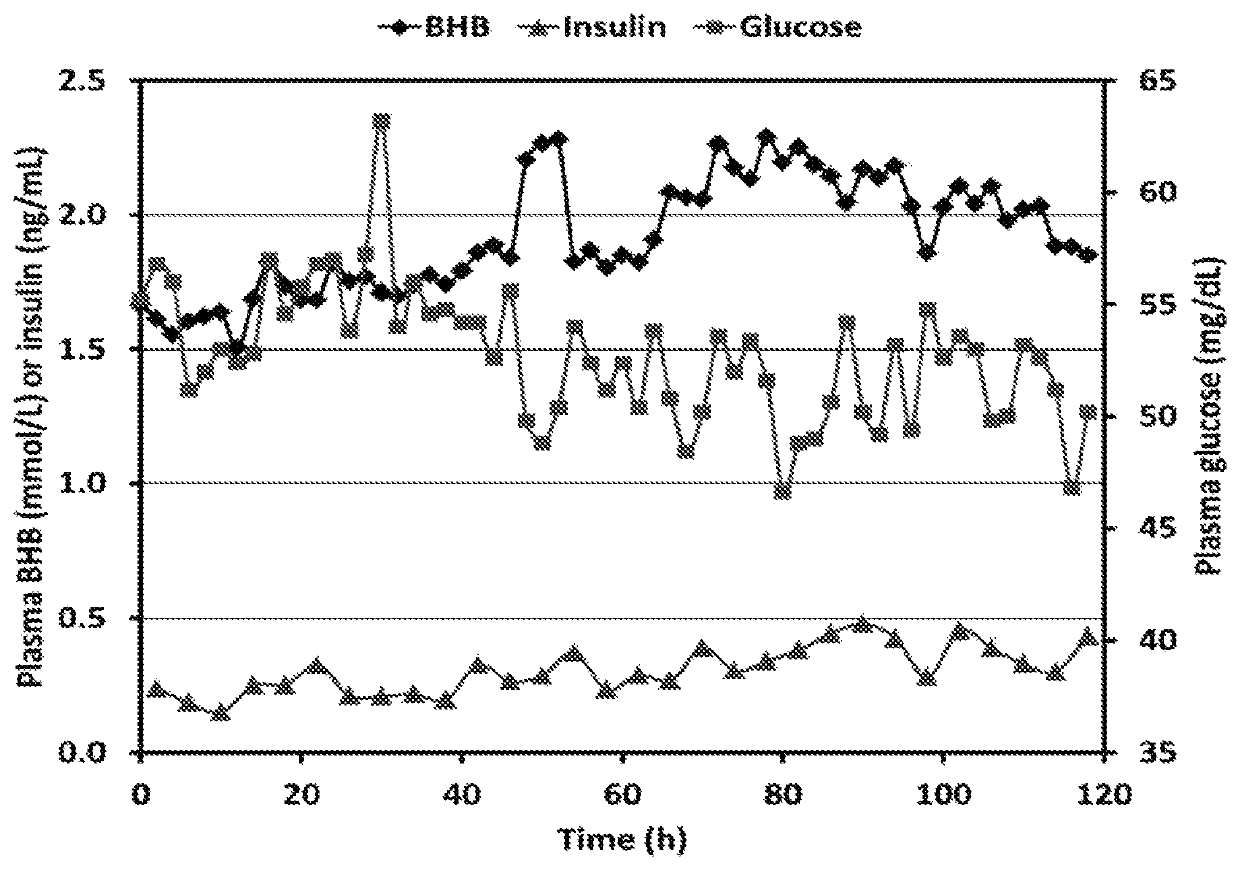Reduced pressure maillard synthesis of carbohydrate energy supplement for ruminant livestock
a technology of ruminant livestock and energy supplement, which is applied in the field of reduced pressure maillard synthesis of carbohydrate energy supplement for ruminant livestock, can solve the problems of limited use of carbohydrates, and achieve the effect of treating or preventing stress in ruminant animals
- Summary
- Abstract
- Description
- Claims
- Application Information
AI Technical Summary
Benefits of technology
Problems solved by technology
Method used
Image
Examples
example 1
m Feeding of a Rumen-Protected Carbohydrate Increases Plasma Insulin Concentrations in Early Postpartum Dairy Cows
[0071]Low blood glucose concentrations early postpartum are associated with low blood insulin concentrations, postpartum metabolic disorders, and infertility. The hypothesis was that short-term feeding of a rumen protected carbohydrate (RUPCA; 56% soybean meal, 40% soluble carbohydrates, 3.2% urea, and 0.8% minerals) would increase blood insulin concentrations by increasing glucose supply from the gastrointestinal tract. Lactating dairy cows (4 Holstein and 1 Guernsey; 17±2 DIM; 30.9±4.6 kg milk and 13.7±2.6 kg DMI per day) were jugular catheterized, barn housed, and milked 2X. During the first 24 h (day 1), cows were fed a nutritionally balanced TMR (corn silage, haylage, wet brewer grains, dry corn, alfalfa hay, rumen protected and unprotected soybean meal, soyhulls, and premix). After 24 h (d 2, 3, and 4), cows were fed the TMR with the RUPCA added at 10% of diet DM. ...
example 2
ic Responses to Feeding Rumen-Protected Glucose (RUPCA) to Lactating Dairy Cows
[0073]We hypothesized that supplementing RUPCA would increase concentrations of glucose and insulin resulting in decreased activity of liver cytochromes P450 2C and P450 3A, thus increasing blood progesterone. Estrus and ovulation were synchronized in 62 Holstein cows using GnRH and PGF2α, (d 0=ovulation). Cows were milked thrice daily and assigned randomly to be fed individually a TMR supplemented with 0, 1, 2, or 4 kg of a RUPCA product top-dressed into the diet beginning on d −3. Blood was collected pre-feeding and 8 h after feeding on d 0, 2, and 4 to determine concentrations of glucose and insulin concentrations and daily from d 2 through 12 to assess progesterone. Blood was collected every 4 h for 24 h on d 8 to assess a circadian pattern in progesterone. Diameter of the corpus luteum (CL) was determined by ultrasonography on d 10. On d 8, feed intake (FI; P=0.68), ECM (P=0.72), ECM:FI (P=0.52), som...
example 3
Rumen Protected Carbohydrate Supplementation on Performance in Feedlot Finishing Steers During Heat Stress
[0075]Finishing steers during the summer can be challenging due to the effects of high temperatures and humidity on DMI. The objective of this study was to evaluate the inclusion of a rumen-protected carbohydrate (RUPCA) (U.S. Pat. No. 8,507,025) on performance of finishing steers during heat stress. Temperature-humidity index average measured every day during the experiment was 72±4.9. Crossbred steers (n=135; 355±20 kg) were used in a 62-d experiment. Steers were blocked by initial BW and placed into 15 pens. Steers within blocks were randomly assigned to 3 treatments: T0=fed 91.4% of a basal diet (% DM), 22.3% corn silage, 65.9% dry corn, 0.6% sunflower meal, 0.5% urea, 2% minerals and vitamins and 8.6% of a supplement containing (% DM) 58.1% soybean meal, 38.9% soluble carbohydrates, 2% urea and 1% minerals salts; T1=fed the basal diet plus 4.3% supplement and 4.3% RUPCA; an...
PUM
 Login to View More
Login to View More Abstract
Description
Claims
Application Information
 Login to View More
Login to View More - R&D
- Intellectual Property
- Life Sciences
- Materials
- Tech Scout
- Unparalleled Data Quality
- Higher Quality Content
- 60% Fewer Hallucinations
Browse by: Latest US Patents, China's latest patents, Technical Efficacy Thesaurus, Application Domain, Technology Topic, Popular Technical Reports.
© 2025 PatSnap. All rights reserved.Legal|Privacy policy|Modern Slavery Act Transparency Statement|Sitemap|About US| Contact US: help@patsnap.com

